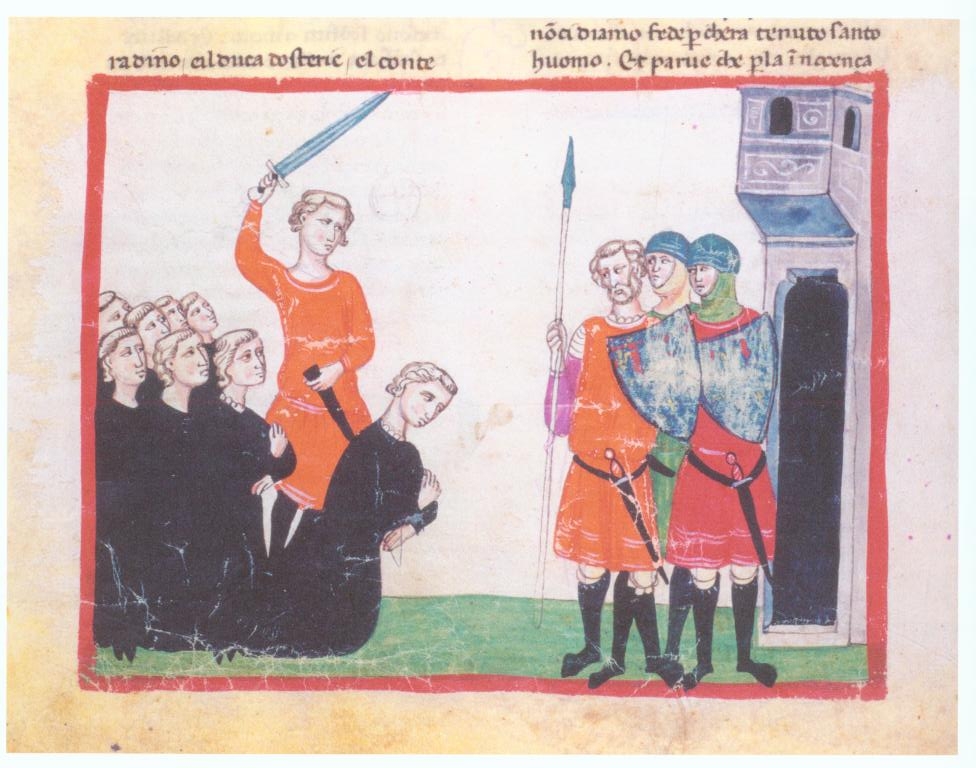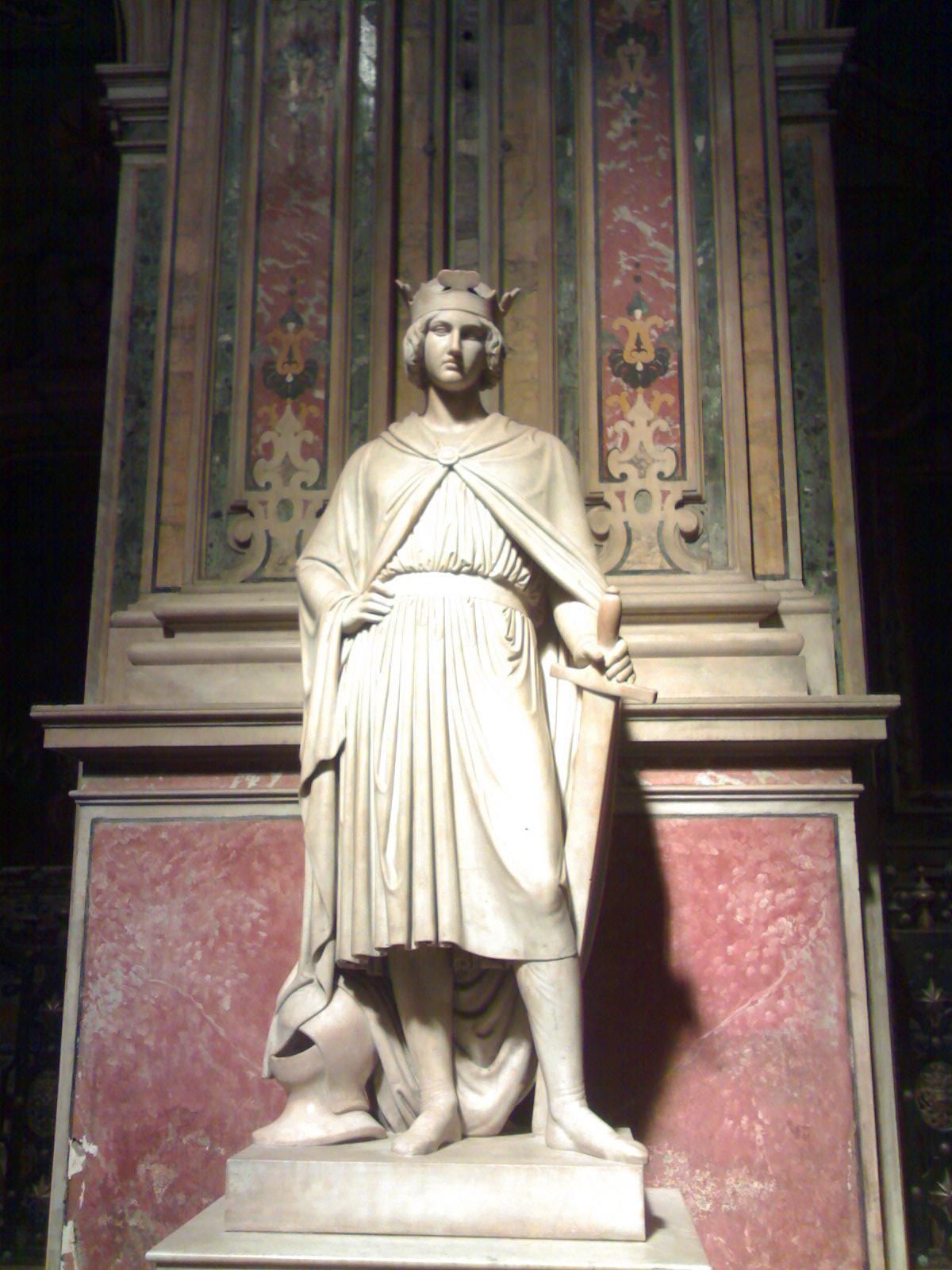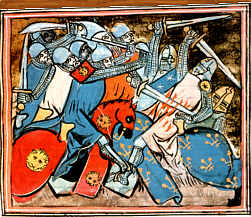|
1268
Year 1268 ( MCCLXVIII) was a leap year starting on Sunday (link will display the full calendar) of the Julian calendar. Events By topic War and politics * February 18 – Battle of Rakvere: The Livonian Order is defeated by Dovmont of Pskov. * April 4 – A five-year Byzantine–Venetian peace treaty is concluded between Venetian envoys and Emperor Michael VIII Palaiologos. It is ratified by the Doge of Venice Reniero Zeno on 30 June. * August 23 – Battle of Tagliacozzo: The army of Charles of Anjou defeats the Ghibellines supporters of Conradin of Hohenstaufen, marking the fall of the Hohenstaufen Family from the Imperial and Sicilian thrones, and leading to the new chapter of Angevin domination in Southern Italy. * October 29 – Conradin, the last legitimate male heir of the Hohenstaufen Dynasty of Kings of Germany and Holy Roman Emperors, is executed, along with his companion Frederick I, Margrave of Baden, by Charles I of Sicily, a political ri ... [...More Info...] [...Related Items...] OR: [Wikipedia] [Google] [Baidu] |
Byzantine–Venetian Treaty Of 1268
In 1268, the Byzantine Empire and the Republic of Venice agreed to temporarily end the hostilities which had erupted after the Byzantine recovery of Constantinople by Emperor Michael VIII Palaiologos in 1261. Venice had enjoyed a privileged position in the Constantinople-based Latin Empire established by the Fourth Crusade in 1204, while Palaiologos had allied with Venice's main commercial rival, the Republic of Genoa, against them. The loss of Constantinople to Palaiologos was a heavy blow to Venice's political and commercial position in the East, as it cut off access to the Black Sea, and gave the Genoese privileged access instead. A naval war against Genoa and Byzantium followed, but despite a significant Venetian victory at the Battle of Settepozzi in 1263, it failed to produce decisive results. Nevertheless, Palaiologos became dissatisfied with the Genoese military performance, and the two allies grew increasingly mistrustful towards each other, leading the Byzantine emper ... [...More Info...] [...Related Items...] OR: [Wikipedia] [Google] [Baidu] |
Conradin
Conrad III (25 March 1252 – 29 October 1268), called ''the Younger'' or ''the Boy'', but usually known by the diminutive Conradin (german: link=no, Konradin, it, Corradino), was the last direct heir of the House of Hohenstaufen. He was Duke of Swabia (1254–1268) and nominal King of Jerusalem (1254–1268) and Sicily (1254–1258). After his attempt to reclaim the Kingdom of Sicily for the Hohenstaufen dynasty failed, he was captured and beheaded. Early childhood Conradin was born in Wolfstein, Bavaria, to Conrad IV of Germany and Elisabeth of Bavaria. Though he never succeeded his father as Roman-German king, he was recognized as king of Sicily and Jerusalem by supporters of the Hohenstaufens in 1254. Having lost his father in 1254, he grew up at the court of his uncle and guardian, Louis II, Duke of Bavaria. His guardians were able to hold Swabia for him. Jerusalem was held by a relative from the royal house of Cyprus as regent. In Sicily, his father's half-brothe ... [...More Info...] [...Related Items...] OR: [Wikipedia] [Google] [Baidu] |
Konradin
Conrad III (25 March 1252 – 29 October 1268), called ''the Younger'' or ''the Boy'', but usually known by the diminutive Conradin (german: link=no, Konradin, it, Corradino), was the last direct heir of the House of Hohenstaufen. He was Duke of Swabia (1254–1268) and nominal King of Jerusalem (1254–1268) and Sicily (1254–1258). After his attempt to reclaim the Kingdom of Sicily for the Hohenstaufen dynasty failed, he was captured and beheaded. Early childhood Conradin was born in Wolfstein, Bavaria, to Conrad IV of Germany and Elisabeth of Bavaria. Though he never succeeded his father as Roman-German king, he was recognized as king of Sicily and Jerusalem by supporters of the Hohenstaufens in 1254. Having lost his father in 1254, he grew up at the court of his uncle and guardian, Louis II, Duke of Bavaria. His guardians were able to hold Swabia for him. Jerusalem was held by a relative from the royal house of Cyprus as regent. In Sicily, his father's half-brother Ma ... [...More Info...] [...Related Items...] OR: [Wikipedia] [Google] [Baidu] |
Reniero Zeno
Coat of arms of Reniero Zeno Silver Grosso of Doge Raniero Zeno, 1253–1268, Venice. Reniero Zeno ( vec, Renieri Zen) (died 7 July 1268) was the 45th Doge of Venice, reigning from 1 January 1253 until his death in 1268. Life The first references to Reniero Zeno in historical sources describe him as a diplomat in France and Italy, where he was excommunicated for having pushed Bologna to avoid paying tributes to the Papal States. In 1240 he helped Doge Jacopo Tiepolo during the siege of Ferrara, in 1242 put down a revolt in Zara and in 1244 he was named '' capitano generale da Mar'' (fleet commander) of the Republic of Venice. He was also the ''podestà'' (Chief Magistrate) of numerous Italian cities. After the death of Marino Morosini, Zeno, who was then ''podestà'' of Fermo, was elected Doge with 21 out of 41 votes. In 1256–1259 he, already lifted from the excommunication, helped Pope Alexander IV and Treviso in the war for the Marca Trevigiana against the Ghibelline ... [...More Info...] [...Related Items...] OR: [Wikipedia] [Google] [Baidu] |
Charles I Of Sicily
Charles I (early 1226/12277 January 1285), commonly called Charles of Anjou, was a member of the royal Capetian dynasty and the founder of the second House of Anjou. He was Count of Provence (1246–85) and Forcalquier (1246–48, 1256–85) in the Holy Roman Empire, Count of Anjou and Maine (1246–85) in France; he was also King of Sicily (1266–85) and Prince of Achaea (1278–85). In 1272, he was proclaimed King of Albania, and in 1277 he purchased a claim to the Kingdom of Jerusalem. The youngest son of Louis VIII of France and Blanche of Castile, Charles was destined for a Church career until the early 1240s. He acquired Provence and Forcalquier through his marriage to their heiress, Beatrice. His attempts to restore central authority brought him into conflict with his mother-in-law, Beatrice of Savoy, and the nobility. Charles received Anjou and Maine from his brother, Louis IX of France, in appanage. He accompanied Louis during the Seventh Crusade to Egypt. Short ... [...More Info...] [...Related Items...] OR: [Wikipedia] [Google] [Baidu] |
Charles Of Anjou
Charles I (early 1226/12277 January 1285), commonly called Charles of Anjou, was a member of the royal Capetian dynasty and the founder of the second House of Anjou. He was Count of Provence (1246–85) and Forcalquier (1246–48, 1256–85) in the Holy Roman Empire, Count of Anjou and Maine (1246–85) in France; he was also King of Sicily (1266–85) and Prince of Achaea (1278–85). In 1272, he was proclaimed King of Albania, and in 1277 he purchased a claim to the Kingdom of Jerusalem. The youngest son of Louis VIII of France and Blanche of Castile, Charles was destined for a Church career until the early 1240s. He acquired Provence and Forcalquier through his marriage to their heiress, Beatrice. His attempts to restore central authority brought him into conflict with his mother-in-law, Beatrice of Savoy, and the nobility. Charles received Anjou and Maine from his brother, Louis IX of France, in appanage. He accompanied Louis during the Seventh Crusade to Egypt. S ... [...More Info...] [...Related Items...] OR: [Wikipedia] [Google] [Baidu] |
Frederick I, Margrave Of Baden
Frederick I of Baden (1249 – October 29, 1268), a member of the House of Zähringen, was Margrave of Baden and of Verona, as well as claimant Duke of Austria from 1250 until his death.Regesten der Markgrafen von Baden und Hachberg, 1050-1515. Innsbruck 1892 As a fellow campaigner of the Hohenstaufen king Conradin, he likewise was beheaded at the behest of King Charles I of Naples. Claim to Austria He was born in Austrian Alland, the only son of the Swabian margrave Herman VI of Baden (c.1226–1250) and his wife Gertrude (1226–1288), niece and heiress of the late Babenberg duke Frederick II of Austria. As Duke Frederick II of Austria had been killed at the 1246 Battle of the Leitha River, the ducal line of the Babenberg dynasty had become extinct. Margrave Herman VI of Baden, through his marriage with Gertrude, had raised inheritance claims to the Austrian and Styrian possessions. However, after the death of Emperor Frederick II in 1250, no strong Imperial authority ex ... [...More Info...] [...Related Items...] OR: [Wikipedia] [Google] [Baidu] |
Hohenstaufen
The Hohenstaufen dynasty (, , ), also known as the Staufer, was a noble family of unclear origin that rose to rule the Duchy of Swabia from 1079, and to royal rule in the Holy Roman Empire during the Middle Ages from 1138 until 1254. The dynasty's most prominent rulers – Frederick I (1155), Henry VI (1191) and Frederick II (1220) – ascended the imperial throne and also reigned over Italy and Burgundy. The non-contemporary name of 'Hohenstaufen' is derived from the family's Hohenstaufen Castle on the Hohenstaufen mountain at the northern fringes of the Swabian Jura, near the town of Göppingen. Under Hohenstaufen rule, the Holy Roman Empire reached its greatest territorial extent from 1155 to 1268. Name The name Hohenstaufen was first used in the 14th century to distinguish the 'high' (''hohen'') conical hill named Staufen in the Swabian Jura (in the district of Göppingen) from the village of the same name in the valley below. The new name was only applied to the h ... [...More Info...] [...Related Items...] OR: [Wikipedia] [Google] [Baidu] |
Battle Of Wesenberg (1268)
The Battle of Wesenberg, Rakvere or Rakovor was a battle fought on 18 February 1268 between the combined forces of Danish Duchy of Estonia, Bishopric of Dorpat, Livonian branch of the Teutonic Knights, and local Estonian militia on one side and the forces of Novgorod and Pskov, led by Dmitry of Pereslavl, on the other. Medieval accounts of the battle vary with both sides claiming victory, however the Livonian victory being more plausible as Novgorodian-Pskovian forces retreated out of Danish Estonia, with Livonian Knights launching a retaliatory attack on Izborsk and Pskov soon afterward, in June 1269. Account of the Livonian Rhymed Chronicle According to the Livonian Rhymed Chronicle, the only contemporary primary source describing the battle whose text survives in unaltered form to the present day, the combined forces of the two Russian republics invaded the territory of Danish Estonia in January 1268 where they commenced with looting of the countryside. The Danish v ... [...More Info...] [...Related Items...] OR: [Wikipedia] [Google] [Baidu] |
Battle Of Tagliacozzo
The Battle of Tagliacozzo was fought on 23 August 1268 between the Ghibelline supporters of Conradin of Hohenstaufen and the Guelph army of Charles of Anjou. The battle represented the last act of Hohenstaufen power in Italy. The capture and execution of Conradin a couple of months after the battle also marked the fall of the family from the Imperial and Sicilian thrones, leading to the new chapter of Angevin domination in Southern Italy. Antecedents The German emperors of the Hohenstaufen line, who had inherited the kingdom of Sicily from its Norman rulers in 1197, had continually attempted to consolidate their more long-standing claims to northern Italy as well—an ambition which was vehemently opposed by many northern Italian states and by the Papacy. The resulting struggle between the Papacy and the Holy Roman Empire split the loyalties of many Italians and led to factionalism, the resulting factions being termed the Guelphs and Ghibellines. The death of the German ... [...More Info...] [...Related Items...] OR: [Wikipedia] [Google] [Baidu] |
County Of Wernigerode
The County of Wernigerode (german: Grafschaft Wernigerode) was a state of the Holy Roman Empire which arose in the Harzgau region of the former Duchy of Saxony, at the northern foot of the Harz mountain range. The comital residence was at Wernigerode, now part of Saxony-Anhalt, Germany. The county was ruled by a branch of the House of Stolberg from 1429 until its mediatization to the Kingdom of Prussia in 1806. Nevertheless, the county remained in existence - with one short interruption - until the dissolution of the Kingdom of Prussia in 1918. History The counts of Wernigerode had established themselves as relatively independent, aristocratic rulers in the Eastphalian lands north of the Harz range, rivalling with the comital House of Regenstein. For more than two centuries from the High Middle Ages, they ruled over extended estates stretching from the Oker river in the west to the glacial valley of the Großes Bruch. The male line finally died out in 1429. Establishment In ... [...More Info...] [...Related Items...] OR: [Wikipedia] [Google] [Baidu] |
Doge Of Venice
The Doge of Venice ( ; vec, Doxe de Venexia ; it, Doge di Venezia ; all derived from Latin ', "military leader"), sometimes translated as Duke (compare the Italian '), was the chief magistrate and leader of the Republic of Venice between 726 and 1797. Doges of Venice were elected for life by the Venetian nobility. The '' doge'' was neither a duke in the modern sense, nor the equivalent of a hereditary duke. The title "doge" was the title of the senior-most elected official of Venice and Genoa; both cities were republics and elected doges. A doge was referred to variously by the titles "My Lord the Doge" ('), "Most Serene Prince" ('), and " His Serenity" ('). History of the title Byzantine era The office of doge goes back to 697. The first historical Venetian doge, Ursus, led a revolt against the Byzantine Empire in 726, but was soon recognised as the () and (a honorific title derived from the Greek word for consul) of Venice by imperial authorities. After Ursus, the Byz ... [...More Info...] [...Related Items...] OR: [Wikipedia] [Google] [Baidu] |

.jpg)





